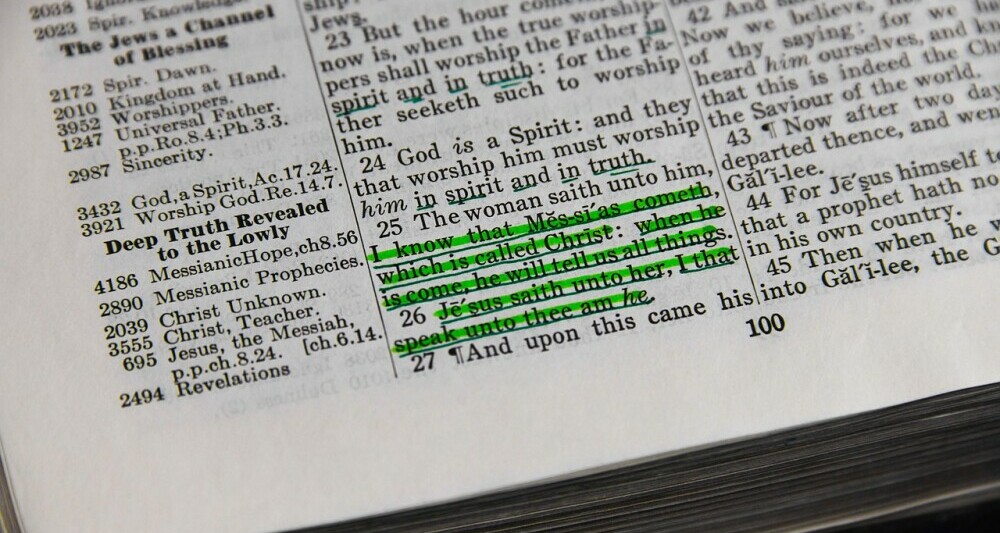The Unique Features Of The Gospel Of Luke
The Gospel of Luke, written by Luke, a companion of the Apostle Paul, offers a unique perspective on Jesus’s life and teachings. Emphasizing social justice, inclusivity, and compassion, Luke portrays Jesus as a revolutionary figure who interacts with marginalized groups, elevates women in ministry, and emphasizes themes of grace and mercy. The Gospel’s literary sophistication, thematic organization, and theological insights highlight Jesus as a compassionate Savior who empathizes with human struggles. By comparing Luke’s Gospel with the other synoptic Gospels, readers can appreciate its distinct perspective and contribution to the Christian narrative, making it a rich source of spiritual inspiration and understanding.

The Gospel of Luke
Today, I’m going to be talking about a remarkable piece of literature and a foundational text for millions: the Gospel of Luke.
This isn’t just about recounting the life and teachings of Jesus; it’s also about understanding the unique lens through which the author, traditionally believed to be Luke, showcases the narrative.
Luke’s Gospel is one part of the larger New Testament corpus, penned in the first century CE—specifically, historians place its composition between 70 and 90 CE.
It’s fascinating to see how Luke combines meticulous historical detail with the profound spiritual insights of Christianity’s early days.
At the core of his narrative is a message intended for a wide audience, spanning Jews and Gentiles alike, making it a unifying document of its time.
Don’t worry too much about being a historical expert to appreciate Luke’s Gospel. What you need to know is that this text is believed to have been written by a companion of the Apostle Paul, namely Luke, who, besides being a devoted follower, was also a physician. His background in medicine may well have influenced his detailed and compassionate approach to storytelling.
Having set the stage with an introduction to the Gospel according to Luke, let’s delve into the distinctive themes that stand out in this rich text.
These themes not only distinguish Luke from the other gospels but also offer a lens through which the message and ministry of Jesus can be appreciated afresh.
 Jesus and His Family
Jesus and His Family
Examining Signature Themes of The Gospel of Luke
One of the most compelling aspects of Luke’s Gospel is the strong emphasis on social justice and the inclusion of marginalized groups. You’re going to find out about how Luke paints a picture of Jesus as a social revolutionary of sorts.
He’s not content to let the status quo oppress individuals who are outcasts in society. Luke makes it a point to show Jesus interacting with tax collectors, Samaritans, and women, who were often looked down upon in first-century Jewish society.
The stories of the Good Samaritan and the Prodigal Son are perfect examples of this, as they emphasise themes of compassion, inclusion, and an inversion of cultural expectations.
Next, let’s talk about the focus on prayer and the role of the Holy Spirit, which are very distinctive in Luke’s Gospel.
Prayer isn’t just a casual mention; it’s the lifeline of Jesus’ ministry.
Instances like the Lord’s Prayer and Jesus praying at Gethsemane illustrate this deeply personal and instructional approach to prayer.
The Holy Spirit is no background character either. This divine presence is front and center from Jesus’ birth narrative to his baptism, heavily influencing his ministry. This sets Luke’s account apart, highlighting a sense of divine empowerment and guidance throughout Jesus’ life.
Lastly, Luke’s spotlight on the universality of salvation suggests that his Gospel is an invitation extended to everyone, far beyond the Jewish audience. This includes tracing Jesus’ lineage all the way back to Adam, emphasizing that Jesus is relevant to humankind at large.
In addition, when Jesus issues the Great Commission in Luke, he makes it clear that the message of repentance and forgiveness should be preached to all nations, thus setting the stage for the mission to the Gentiles.
 The Good Samaritan
The Good Samaritan
Exclusive Stories and Parables in The Gospel of Luke
Now, let’s explore some of the storytelling gems found exclusively in Luke’s Gospel.
The third evangelist paints a vivid portrait of Jesus through several unique parables and narratives that only he recounts. These stories hold significant meaning and have been a rich source of theological reflection and spiritual inspiration for generations.
Parables like the Good Samaritan and the Prodigal Son are well-known even beyond Christian circles, testifying to the enduring power of these tales. However, it’s not just their popularity that’s worth noting. These stories encapsulate deep ethical teachings and reveal Christ’s revolutionary perspective on God’s kingdom, grace, and mercy.
We don’t just get parables; Luke also feeds our curiosity about Jesus’s early life. From the Annunciation to Mary to the Nativity and the Presentation in the Temple, Luke’s detailed infancy narratives provide a unique look at the beginnings of Jesus. These accounts shape our understanding of Jesus’s divine identity and human experience from the very start.
Moreover, Luke’s Gospel offers a refreshing perspective through its inclusion and elevation of women in Jesus’s ministry. We hear of the faith and contributions of Mary and Martha, the widow of Nain, and the repentant woman who anoints Jesus’s feet, among others. Luke ensures these stories are heard, highlighting the vital role women played in the Jesus movement.
These unique narrative elements in Luke add to the richness of his Gospel and they also set the stage for an understanding of Jesus’s teachings that are more inclusive, compassionate, and rooted in a loving God who cares deeply about the individual, especially those on the fringes of society.
 Old Bibles
Old Bibles
The Artistry of Luke – Literary Style and Structure
You might be curious about what makes the Gospel of Luke different in terms of writing style and organization. Well, it’s not just the content that’s compelling; it’s also how it’s expressed and structured.
Luke’s Gospel exhibits a high level of Greek sophistication, reflecting the author’s likely well-educated background. It’s a text that showcases the careful selection of words and phrases, crafted deliberately to resonate with both the heart and the mind.
This author knows how to use literary devices with expertise. Expect to encounter parallelism, where phrases or sentences mirror each other to emphasize a point. Chiasmus, a method where concepts are introduced and then revisited in reverse order, adds depth and symmetry to the ideas being presented. Inclusio is another technique you’ll find, where a section of text is bracketed by repeating a theme or phrase, creating a sense of completeness.
Luke doesn’t just throw together a series of events; he organizes them with intent. You won’t find a strict chronological roadmap to Jesus’ life here. Instead, Luke groups his material by themes, arranging narratives around concepts like prayer, discipleship, and salvation. This thematic approach unifies Luke’s message and often makes connections and nuances more apparent, facilitating a deeper understanding of the material.
Transitioning from Luke’s stylistic choices to its theological depths, the Gospel’s literary finesse sets the stage for its rich theological messages. In the next section, we’ll explore the profound theological emphases of the Gospel of Luke, where the compassion and humanity of Jesus are brought to the forefront in a way that is meant to both instruct and inspire.
 Bible Reading
Bible Reading
Theological Insights of the Gospel of Luke
If you’re looking to comprehend the heart of Christian theology within the synoptic Gospels, diving into the teachings of Luke is essential. His approach provides a historical account and it offers a dimension of theology so deep yet accessible that it resonates with readers across ages.
Now what’s particularly striking in Luke’s writings is the emphasis he places on concepts like compassion, mercy, and forgiveness. This is about narrating events and showcasing a Jesus who meets people at their point of need, who includes the excluded and forgives the errant. Through stories such as the healing of the ten lepers and the forgiveness extended to the criminal on the cross, Luke paints a picture of a Christ deeply moved by love and ready to restore those around him.
Another pillar in Luke’s theological framework is the recurring call to repentance paired with the assurance of salvation. Throughout the Gospel, there is a clarion call to turn away from wrongdoing, with Jesus’s ministry vividly illustrating this message.
For instance, the transformation of Zacchaeus exemplifies individual repentance leading to salvation—a theme I find profoundly compelling.
Moreover, Luke’s portrayal of Jesus as the compassionate Savior and the Son of Man is far from one-dimensional. It highlights Jesus’ humanity and his solidarity with human suffering.
His healings, his moments of weeping, and even his enjoyment of a meal with friends highlights that he’s one of us, yet without fault—a Savior who not only teaches us but empathizes with our struggles.
This understanding of Jesus, cultivated in Luke’s Gospel, is instrumental for grasping the full scope of his ministry.
Now, as we transition to the comparative analysis in the following section, you’re going to find out about the unique perspectives Luke provides by placing his account side by side with the narratives of Matthew and Mark.
 Bible Reading and Mediation
Bible Reading and Mediation
Reflections on Narrative of The Gospel of Luke
In our journey through the Gospel of Luke, we’ve uncovered a tapestry of themes and narratives that set it apart from the other Gospels. The unique parables and the focus on marginalized individuals weave together to offer a profound understanding of Jesus’ ministry.
Luke’s Gospel stands out for its compassionate portrayal of Jesus, an emphasis that threads through the narrative like a golden seam. The inclusion of social outcasts, an unwavering focus on prayer, and the pivotal role of the Holy Spirit highlights the universality of Jesus’s message of salvation and his invitation to a life of discipleship.
The literary finesse of Luke’s account, with its polished Greek and masterful use of literary devices, showcases the author’s educational background, ensuring that the message is not just heartfelt but also compelling and authoritative. Here, the sophistication of language goes hand in hand with the deep theology it conveys.
Comparing Matthew, Mark, and Luke brings to light the distinct perspective Luke provides. While maintaining the synoptic tradition, Luke offers a fresh lens through which to view Jesus’ life and teachings, one that resonates with hope and inclusivity.
I really hope that this exploration into the Gospel of Luke has illuminated its unique contribution to the New Testament. By appreciating Luke’s particular points of emphasis and literary style, one can gain a richer, more nuanced appreciation of the Christian narrative.
Remember, your first reading of Luke doesn’t need to be your last. Each encounter with the text can offer new insights and deeper understanding. Choose to approach Luke’s Gospel with openness, allowing its distinctive voice to speak to your context and experiences today. And if you need guidance, let me know in the comment section below, I’m here to help you navigate this profound work.
In This Series
An Overview Of The New Testament
The Historical Background Of The NT
Key Themes In The NT
The Gospel Of Matthew – Taking A Closer Look
The Unique Features Of The Gospel Of Luke
The Theology Of The Gospel Of John
Understanding The Acts Of The Apostles
Paul – His Life, Ministry, And Epistles
Understanding The Book Of Revelation
by Paul, M.






Hi!
I’m in love with the gospels. I know that many historians tried to prove in the past that Luke is not trustworthy, but over the years it became clear and a consensus, that Luke was an exceptional historian!
I love your parables with the other gospels. Each of them is unique in its own way, aren’t they?
Are there quotes from Jesus in Luke’s writings, that can not be found in the other gospels?
Hello!
I’m glad to hear that you appreciate the Gospel of Luke. Luke indeed stands out as a meticulous historian and his unique perspective adds depth to the overall gospel narrative.
One of the unique features of the Gospel of Luke is the inclusion of parables that are not found in the other gospels. For example, the parables of the Good Samaritan (Luke 10:25-37) and the Prodigal Son (Luke 15:11-32) are exclusive to Luke’s gospel.
In terms of quotes from Jesus that can only be found in Luke, one example is the famous saying of Jesus on the cross: “Father, forgive them, for they do not know what they are doing” (Luke 23:34). This powerful statement of forgiveness is unique to Luke’s gospel.
Overall, the Gospel of Luke offers a unique perspective on the life and teachings of Jesus, and I encourage you to continue exploring its richness and depth.
Blessings!
The Gospel of Luke is truly fascinating, and this article does an excellent job of highlighting its unique features. I was particularly intrigued by the emphasis on Jesus’ compassion and concern for the marginalized, which sets Luke apart from the other Gospels.
One question that arose for me while reading this article is how these unique features of Luke’s Gospel influence our understanding of Jesus’ teachings and mission. How do you think Luke’s portrayal of Jesus impacts our view of Christianity and the role of compassion in our faith?
Thank you for your insightful comment.
The emphasis on Jesus’ compassion and concern for the marginalized truly sets Luke apart from the other Gospels and is a defining characteristic of his portrayal of Jesus.
Luke’s portrayal of Jesus as compassionate and concerned for the marginalized has a significant impact on our understanding of Jesus’ teachings and mission.
It shows us that Jesus’ message was one of love, mercy, and inclusivity, and that he prioritized caring for those who were often overlooked or mistreated in society. This challenges us to do the same in our own lives and to emulate Jesus’ example of compassion towards others.
In terms of Christianity as a whole, Luke’s emphasis on compassion reinforces the idea that love and compassion should be central to our faith.
It reminds us that Christianity is not just about following rules or doctrines, but about embodying the love and grace that Jesus showed to all people, especially the marginalized and disadvantaged.
Overall, Luke’s portrayal of Jesus as compassionate and caring for the marginalized serves as a powerful reminder of the importance of compassion in our faith and challenges us to live out this core value in our own lives.
It calls us to follow Jesus’ example and show love and kindness to all, just as he did. Thank you for sparking this thought-provoking discussion on the impact of Luke’s portrayal of Jesus on our understanding of Christianity and the role of compassion in our faith.